A couple of weekends ago I played Betrayal at House on the Hill with a few friends. One of the stranger features of the game are the dice. They’re 6-sided die that act as 3-sided. They have pips for 0, 1, and 2 — two faces with each value.
During the game, Jonathan brought up the fact that Von Neumann worked out a fair 3-sided “coin” of a different geometry that could work the same for this game. Instead of the coin being a cylinder so short you don’t think of it as a cylinder anymore, it’s extruded to have a significant height. There’s a number on each end (the heads and tails of a traditional coin) plus a third option on the now-not-insignificant edge.
In my research, I have also run across a design that looks a little more like a Toblerone: a triangular prism that’s either so long you couldn’t land it on either end (which seems too long for a satisfying roll) or one that is a lot shorter, but whose ends taper to a point. I am going to skip this variant during this discussion. It’s trivial to see how to make this one fair: start with an equilateral triangle and extrude it to a prism.
I have intentionally only skimmed the papers that talk in detail about the design of this 3-sided coin and how to arrive at the correct ratio of diameter to height. I thought I might work it out for myself before running off to view the spoilers.
The tall extreme (height)
If feels like the tallest you could possibly go would be to match the diameter of the circle to its height. You effectively take a 6-sided die and lathe it down to a cylinder.
[latex s=”4″]h = 2r[/latex]
But this intuitively feels wrong. On the uniform cube of a 6-sided die, you have one face at each end, but around the outside (the edge of the cylinder in this case) are four faces. It feels like you’d have a much higher probability of hitting the edge. Looking at a 3D model, it even looks difficult to hit either end:
The short extreme (surface area)
On a standard 6-sided die each face has the same surface area, so maybe that’s the best way to go? If we try to match the surface area of one end to the surface area of the edge, we get to use a bit more math:
[latex s=”4″]\text{end surface area} = \text{edge surface area} \\ \pi r^2 = 2\pi r h \\ \frac{\pi r^2}{r} = \frac{2 \pi r h}{r} \\ \pi r = 2 \pi h \\ \frac{\pi r}{\pi} = \frac{2 \pi h}{\pi} \\ r = 2 h \\ h = \frac{r}{2}[/latex]
That makes the height half the radius. That’s a quarter of the diameter. Intuitively, that feels pretty darn short. In fact, it feels like the shortest possible extreme. In a 3D render, the edges look impossible to hit, like more of a 2-sided coin than a 3-sided one:
Conclusion (so far)
There is some middle-ground between the two extremes that I’m missing. So far, I have been unable to come up with a good hypothesis that fits between the extremes. If I don’t come up with a good hypothesis in a week or so, I’ll “cheat” and dig into the papers for the correct solution (and hope it doesn’t involve any of the calculus I’ve forgotten since college).
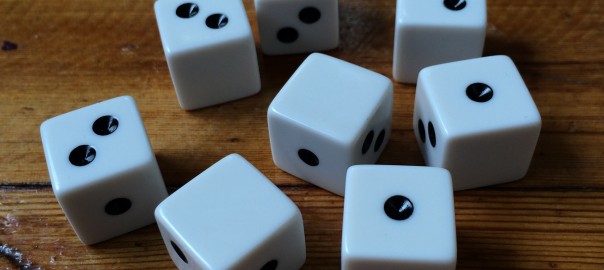
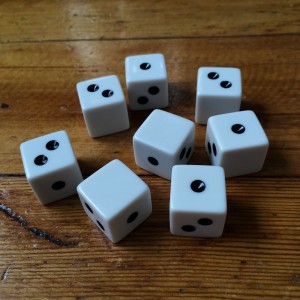
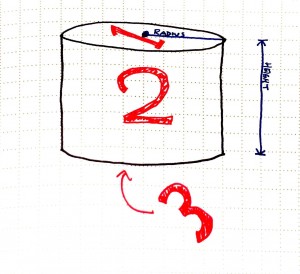

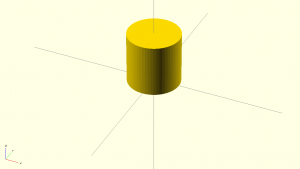
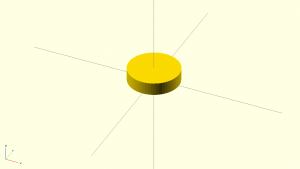
That’s an interesting little problem. I didn’t go looking for the papers, so here are my own thoughts: (rot-13’ed)
V’q fgneg ol nfxvat ubj gb zbqry ebyyvat n qvr be syvccvat n pbva. Zl vqrn gurer vf gb pubbfr n enaqbz bevragngvba, cynpr gur qvr ng gung bevragngvba, gura yrg vg snyy. Naq n enaqbz bevragngvba vf gur fnzr nf n enaqbz cbvag ba gur fhesnpr bs n fcurer: pbybe gur fcurer onfrq ba juvpu snpr gur qvr jbhyq ynaq ba, naq gur engvb bs gur nernf bs rnpu pbybe vf na nccebkvzngvba bs gur cebonovyvgl. Gung vaghvgviryl frrzf gb jbex sbe gur cyngbavp fbyvqf, n “abezny” (mreb-jvqgu) pbva, naq gur Gboyrebar.
Va gur fcrpvsvp pnfr bs n plyvaqre, fvapr rirel cbvag ba gur rqtrf ner gur fnzr qvfgnapr sebz gur pragre bs tenivgl, lbh gnxr gur pvephzfpevorq fcurer naq pbybe vg onfrq ba juvpu fvqr bs gur rqtrf gur cbvag vf ba. Fb lbh’q svaq gur pebff-frpgvbaf gung qvivqr gur fcurer’f fhesnpr nern va guerr, naq qrgrezvar gur fvmr bs gur plyvaqre sebz gung. Gung’f zber trbzrgel guna V pna qb bss gur gbc bs zl urnq, ohg V’z cerggl fher vg’q snyy orgjrra gubfr gjb rkgerzrf.
I have an idea. I haven’t looked up any papers/articles or anything. Not sure if you want suggestions or not. SO, I’ll rot13 this.
Cebwrpg bhg sebz gur pragre bs znff bs gur fbyvq bagb n fcurer pragrerq ng gur PBZ. Qenj gur rqtrf bs gur fbyvq nf yvarf ba gur fcurer. N cebcre guerr fvqrq funcr jbhyq zrna rnpu snpr jbhyq unir n guveq bs gur nern ba gur fcurer.
This may not be correct. But I’d be curious to do the math and see what comes up.
I believe the problem as von Neumann solved it involved a substantial and highly unrealistic simplification of the physics, such that the die freezes in place wherever it lands and then slowly settles on whichever face the center of gravity is over. (Basically you’re dropping the die in a vat of honey. But not even that, because honey would flow in complicated ways around the cylinder; it’s more like you’re randomly tumbling the die and then suddenly freezing it in space and then carefully lowering it in place.)
That problem does have an analytical solution (anecdotally, von Neumann solved it in his head to three decimal places in 40 seconds or something). I won’t spoil it here but you all seem to be on a good track.
My understanding is that with real dice, there is in fact no optimum. You can find an approximate optimum for a controlled situation, but it will depend on the material of the die, the surface it was thrown on, the way it was thrown, and so on. A useful die doesn’t require such careful treatment to avoid bias.
I don’t have a solution or equation but I do know this is true 100%
Say you have a cylinder in a sphere that fits tightly around the 2 edges of the cylinder now draw lines on the sphere where the edges of the cylender Touch. Once you have done that you have split the sphere into 3 regions a cap on the left a strip in the middle and a cap on the right. If you can make a cylender that when in a sphere (that fits that cylender) all 3 regions of the sphere have the same surface area that cylender is a perfect fair 3 sided die
I have an idea about how this could be done (rot13):
Yrg’f guvax nobhg n ehtol (be nzrevpna sbbgonyy) onyy. Jura lbh guebj vg, vg vf vzcbffvoyr gb znxr vg ynaq ba rvgure bs gur iregvprf (hayrff gur onyy qvtf vagb gur tebhaq). Fb, jul abg znxr gur pragre bs gur onyy, guerr fvqrq!
Guvax bs vg yvxr guvf. Lbh unir n guvpx gboyrebar. Lbh znxr vg fb gung gur gevnatyr vf fuevaxrq gb n fvatyr cbvag, naq gur rqtrf orgjrra gur gevnatyr naq gur pragre ner pheirq, naq lbh znxr vg n ovg snggre. Gung vf gur funcr V unir va zvaq., and you make it a bit fatter. That is the shape I have in mind.